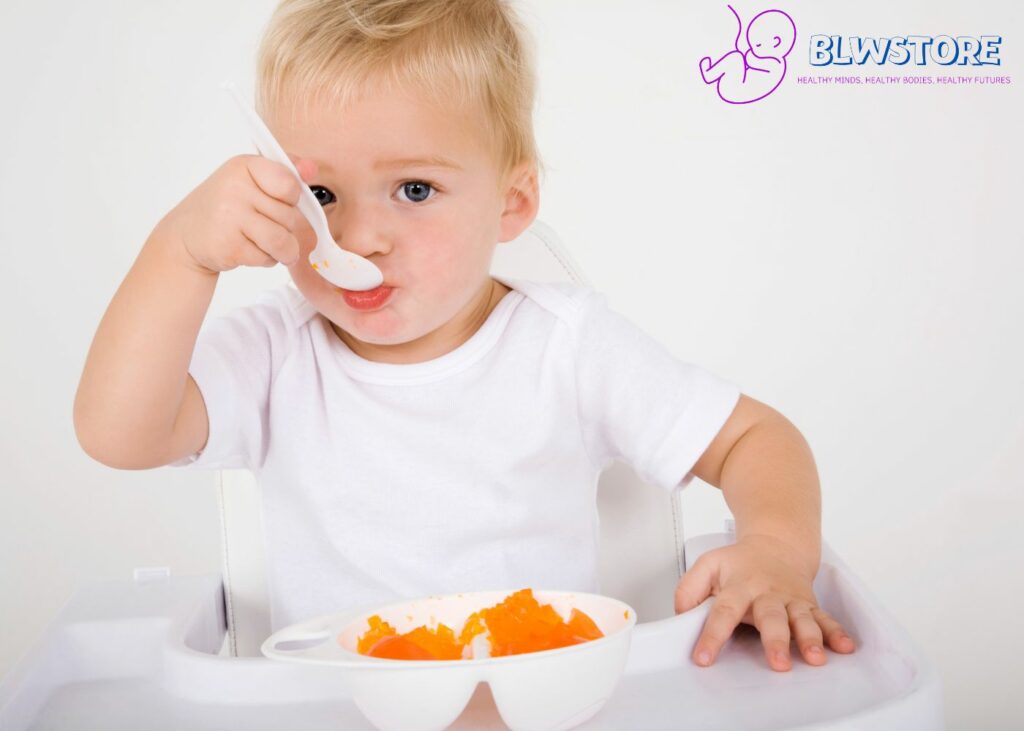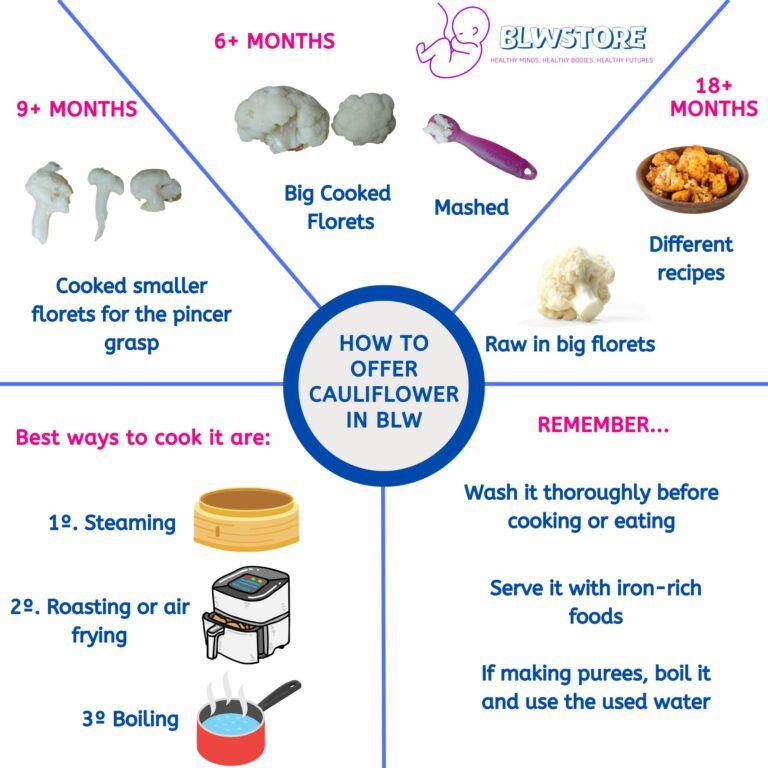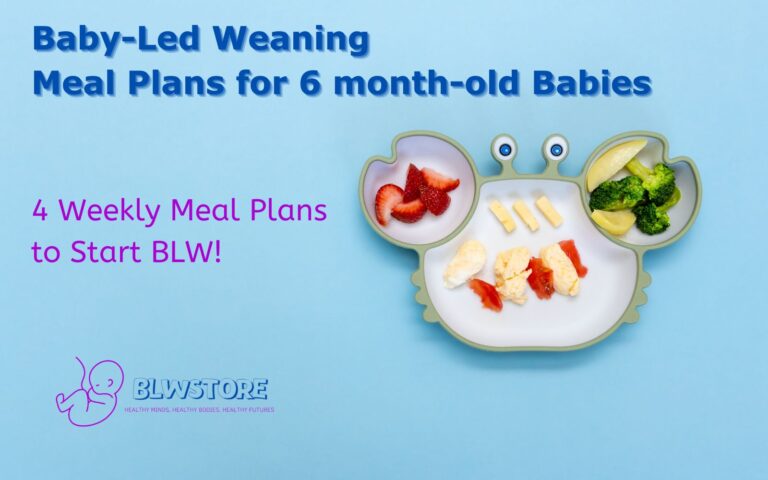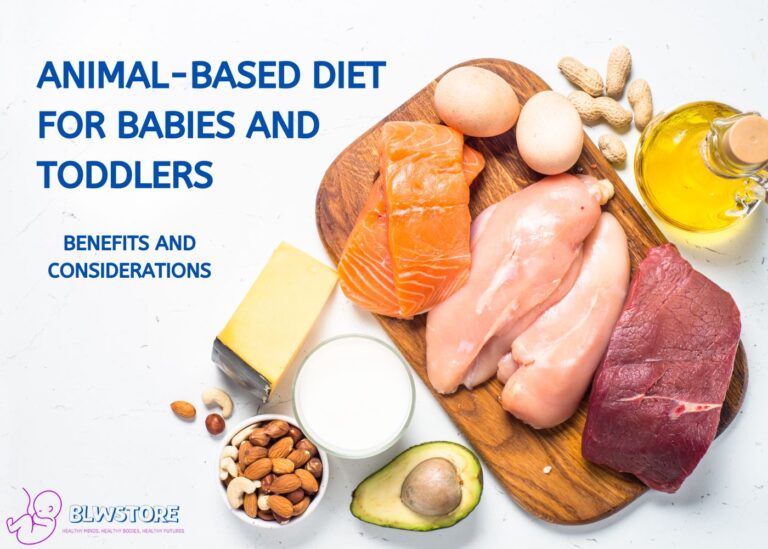
Key Takeaways
Key Takeaways Details Starting BLW at 6 months Ensure your baby can sit unsupported, has lost the tongue-thrust reflex, and shows interest in food. First Foods Start with soft finger foods and gradually introduce textures and flavors while avoiding choking hazards. BLW at 8 months Benefits babies with improved motor skills and a mature digestive system. Offer a broader range of finger foods, new flavors gradually, and focus on variety. BLW at 10 months or later It’s never too late. Offer a variety of textures and flavors, encourage self-feeding, and embrace the mess. Late Introduction of Solids If solids are not introduced before 12 months, it may lead to feeding difficulties and picky eating habits. Tips for successful BLW Be patient, offer a variety of healthy options, and avoid choking hazards. Embrace the journey and celebrate milestones Every child has their own pace with BLW, so don’t be discouraged if it takes time.
*Before reading this article, we recommend you read our complete baby-led weaning guide for a better perspective.
Are you tired of spoon-feeding your baby purees and watching them spit them out?
Have you heard about Baby-Led Weaning (BLW) and wonder what it is all about?
BLW is a method of introducing solid foods to babies that involves letting the baby feed themselves finger foods.
Yes, you read that right! Instead of spoon-feeding, you put the food in front of your little one and let them pick it up, bring it to their mouth and explore its texture and taste.
But why should we choose BLW over traditional spoon-feeding?
There are many benefits to BLW.
First off, research shows that BLW can help prevent fussy eaters because babies who are allowed to self-feed tend to be more adventurous with their food choices later on.
Secondly, BLW encourages independence and fine motor skill development as babies learn to pick up small objects between their fingers.
Self-feeding promotes a positive relationship with food by allowing babies to dictate how much they eat based on their hunger cues.
Knowing all this, let’s see how to start BLW at different ages.
Let’s get after it!
How to Start BLW at 6 Months
To start BLW at 6 months, you’ll want to be sure your baby is developmentally ready for this exciting new phase.
The American Academy of Pediatrics recommends waiting until six months before starting solids, making it the perfect time to begin Baby-Led Weaning.
But what are the signs your little one is ready, and how do you go about introducing solid foods?
BLW readiness: Baby can sit unsupported, lost tongue-thrust reflex, shows interest in food.
Start with soft finger foods, gradually introduce textures and flavors. Avoid choking hazards.
Experiment with safe options. BLW promotes healthy eating habits and self-feeding skills.
Is Your Baby Ready for BLW?
Ask yourself these questions:
Can your baby sit up without support?
Have they lost their tongue-thrust reflex?
Are they showing interest in food?
If the answer to these questions is yes, then it’s time to start your Baby-Led Weaning journey!
Introducing Solid Foods: A Short Step-by-Step Guide
Start with soft finger foods
Offer your baby soft finger foods such as steamed sweet potato or carrot sticks. Make sure to cut the pieces into appropriate sizes for your baby’s grasp (e.g., short enough for them not to choke but long enough for them not to swallow whole).
Gradually introduce more textures and flavors
As your baby gets used to these first offerings, gradually introduce more textures and flavors such as cooked chicken strips or sliced avocado. Remember, BLW is all about allowing your baby to explore food independently at their own pace.
Take it slow and steady
It’s important to take it slow and steady when introducing solids. Start by offering soft finger foods like cooked vegetables or ripe fruits cut into small pieces.
Avoid choking hazards
Steer clear of whole nuts, seeds, or popcorn. Let your baby explore the food without pressure or coercion.
Experiment with different flavors and textures
Don’t limit yourself; feel free to experiment with different flavors and textures as long as they are safe for your little one. Some appropriate first foods include steamed sweet potato sticks, mashed avocado on toast fingers, and banana slices.
Remember, BLW aims to give babies control over their food choices while helping them develop healthy eating habits from an early age.
Starting BLW at 6 months is a safe and effective way of introducing solid foods to babies who are developmentally ready for this important milestone in their lives.
With patience and guidance from parents or caregivers, babies can learn how to self-feed while exploring new tastes and textures that will set them up for a lifetime of healthy eating habits.
How to Start BLW at 8 Months
To start BLW at 8 months, you’ll want to ensure your baby is developmentally ready for this new adventure.
While six months is the recommended age for starting BLW, some parents may choose to wait a little longer for various reasons.
But what are the benefits of waiting, and how should you adjust your approach for older babies?
Waiting until 8 months for BLW can benefit babies with improved motor skills and a mature digestive system.
Offer a broader range of finger foods, introduce new flavors gradually, focus on variety, and introduce more complex textures.
Why Wait to Start BLW?
Some reasons parents may choose to wait until their baby is 8 months old include:
Premature birth
Family history of allergies
Baby’s improved motor skills and ability to sit up independently
By waiting until 8 months, babies may have more developed motor skills and a more mature digestive system, making it easier for them to grasp food and try new flavors.
Adjusting the Approach for Older Babies
Offer a wider range of finger foods with varying textures
At 8 months, your baby can likely handle more advanced textures. Try offering soft cooked vegetables like carrots or broccoli florets, or pieces of fruit like peeled slices of apple.
Introduce new flavors gradually
Older babies may have stronger preferences, so take cues from your baby’s reactions when introducing new flavors. If they seem hesitant, try offering it again another day; if they love it, continue offering that food regularly.
Focus on variety
Offer a good mix of fruits, vegetables, proteins, and carbohydrates. This encourages healthy eating habits and may help prevent picky eaters later on.
Suggestions for Introducing New Textures and Flavors
Offer strips or chunks of meat
Let your baby practice their chewing skills by offering strips or chunks of meat for them to gnaw on.
Introduce more complex textures
As your baby’s chewing skills improve, introduce more complex textures to expand their palate.
Don’t shy away from offering new foods Introducing variety now may help your baby enjoy new tastes and cuisines as they grow up, promoting healthy eating habits.
How to Start BLW at 10 Months
To start BLW at 10 months, it’s important to remember that it’s never too late to begin Baby-Led Weaning!
If your baby is already eating purees or mashed foods, but you want to transition to self-feeding, you can start whenever you feel ready.
Offering a variety of textures and flavors is crucial at this stage, as your little one will likely be more curious about new tastes and textures.
You can start BLW at ten months or later is never too late.
Slowly introduce finger foods alongside purees/mashed foods, offer a variety of foods, encourage self-feeding, embrace the mess, and remember that every baby develops at their own pace.
Modifying the Approach for Babies Already Eating Purees/Mashed Foods
Slowly introduce finger foods
Offer soft finger foods alongside their usual puree or mashed meals. Gradually increase the amount of finger foods offered while decreasing the amount of puree/mashed food being offered.
Be patient
It’s normal for babies to take some time getting used to self-feeding and to spit out some of their food initially.
Ideas for Offering a Wider Variety of Foods and Encouraging Self-Feeding
Offer a variety of fruits, vegetables, meats, and grains
Your baby may have already tried some flavors and textures, but that doesn’t mean you can’t introduce new and exciting foods!
Encourage self-feeding with easy-to-grasp foods
Offer foods like avocado slices, cooked sweet potato wedges, and soft pasta shapes that are easy to grasp and chew.
Embrace the mess
Don’t be afraid to let your baby get messy – it’s all part of the learning process!
Starting BLW at 10 months or later is completely okay.
It’s important to remember that every baby develops at their own pace and there is no set timeline for introducing solid foods.
As long as you follow safe feeding practices like the ones we teach you on this website and offer various healthy options, your baby will develop a positive relationship with food in their own time.
What happens if you don’t introduce solids for 12 months?
If you don’t introduce solids before 12 months, your baby will still receive the necessary nutrients from breastmilk or formula.
However, starting solids too late might lead to feeding difficulties and picky eating habits. Remember that self-feeding encourages exploration and helps develop a positive relationship with food.
Tips for Success
Be Patient
One of the most essential tips for successful BLW is to be patient. Remember, this is the first time your little one is experiencing new foods and textures independently.
It may take several tries before they get the hang of it. Some babies take longer to develop their chewing skills, but don’t worry!
Keep offering a variety of finger foods in different shapes, sizes, and textures so your baby can practice. And always offer encouragement along the way!
Offer a Variety of Healthy Options
We can’t stress the importance of this: offer a variety of healthy options.
While it’s tempting to stick with familiar foods or pre-packaged snacks, remember that your baby needs a balanced diet just like you do.
Try offering a wide range of fruits and vegetables in various colors and textures, healthy proteins like beans or tofu, and whole grains like quinoa or spelt.
Avoid Choking Hazards
Last, always be mindful of choking hazards when introducing solids through BLW.
Foods that can easily break off into small pieces or are difficult to chew (like nuts or raw carrots) should be avoided until your child can handle them safely.
Make sure food is cut into appropriately sized pieces and watch closely as they eat – never leave them alone during mealtimes.
Recommended read: Foods to avoid during BLW
Conclusion
Starting Baby-Led Weaning at any age can be exciting but also nerve-wracking as we navigate this new experience with our little ones.
Remembering these tips – being patient with our babies’ progress, offering a diverse range of healthy food options, and being aware of choking hazards – will help make this journey as smooth as possible for both baby and parent alike!
Remember, every child has their own pace when it comes to BLW, so don’t be discouraged if your child takes longer to get the hang of it.
Embrace the journey and celebrate every milestone along the way!
We’re Maria and Alberto, a married couple and educators who are nutrition enthusiasts. Even before we had kids, we were already crazy about nutrition.
We’d read scientific articles, watch videos from nutritionists, and spend hours listening to nutrition podcasts.
Today, we continue doing this, but in a different way, as we’ve learned to sift through the noise and trends. Nutrition, like any other field of knowledge, the more you read and learn, the more you develop a comprehensive understanding of reality, and that’s what has happened to us.
Before having our first child, we focused on learning everything we could about child nutrition, using the same techniques we had already employed, backed by our extensive knowledge in nutrition.
Our mission is to help other parents with their children’s nutrition, to help them become the best versions of themselves.
If we are what we eat and drink, which is absolutely true, let’s do it right!







